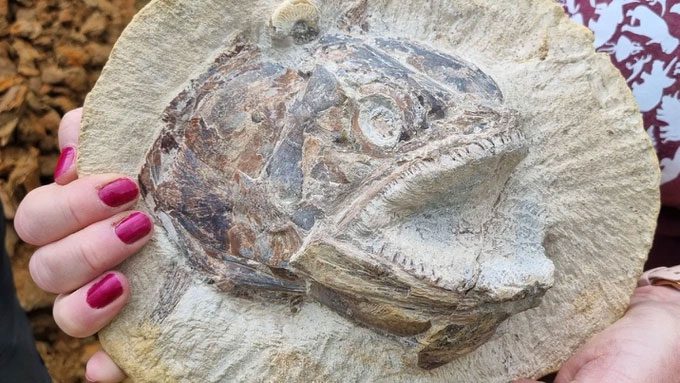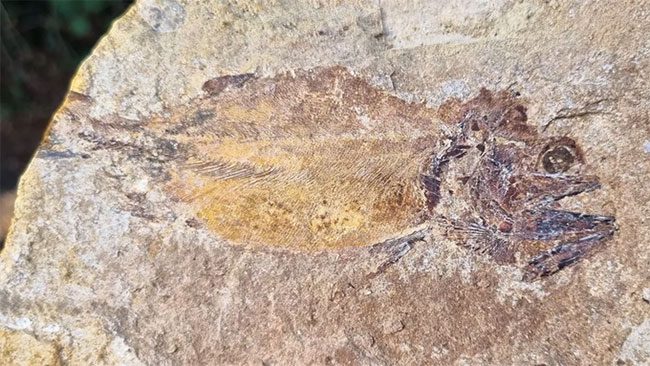This fish fossil has astonished scientists because it resembles no other species ever seen before; it looks like a cartoon fish toy that is singing.
This site contains a treasure trove of fossils that are 183 million years old, located in the outskirts of Gloucestershire in the Cotswolds, United Kingdom.

3D fossil of a fish from the Jurassic period – belonging to the species Pachycormus, is one of over 180 fossils found at a farm in England (Photo: Courtesy of Sally and Neville Hollingworth).
Researchers have discovered fossil remains of fish, giant marine reptiles (ichthyosaurs), squid, insects, and other ancient animals dating back to the early Jurassic period (145 to 201.3 million years ago).
Among the more than 180 fossil specimens recorded during the excavation, one standout specimen is the well-preserved 3D fish head belonging to the extinct species Pachycormus – a type of ray-finned fish.
The fossil found by researchers was “trapped” in a hard limestone block and protruding from clay. It is exceptionally well-preserved, containing soft tissues, including scales and eyes.
Experts have been unable to compare this fossil with any previous discoveries.
Neville Hollingworth, a field geologist from the University of Birmingham who discovered the site, stated: “The closest comparison we could think of for this fossil is Big Mouth Billy Bass (a singing fish toy), with its well-preserved eyeball and eye socket.”
According to Hollingworth, typically, fossils lie flat. However, in this case, the fish is preserved in multiple dimensions, giving the impression that it is leaping out of the rock.

Scales and eyes of the fish are some of the soft tissues preserved for over 180 million years. (Photo: Dean Lomax).
Sally Hollingworth, Neville Hollingworth’s wife and the excavation coordinator, added: “I have never seen anything like this before. We can see scales, skin, the spine – even its eyeball.”
This sight amazed the Hollingworths so much that they contacted ThinkSee3D, a company specializing in digital 3D fossil modeling, to create a detailed image of the fish, allowing experts to study it further.
Most of the fossils that Neville Hollingworth and a team of scientists excavated were located behind the farm’s cow shed.
At one time, this area of the United Kingdom was completely submerged by a shallow tropical sea, and the sediments there may have helped preserve the fossils.
Paleontologist Dean Lomax, a member of the excavation team, explained: “When fish die, they sink to the seabed, and like other fossils, they must have been quickly buried by sediments, which immediately covered and protected them.”
During a four-day excavation in early July, the research team of eight used machinery to dig 262 feet (about 80 meters) into the farm’s grassy banks and discovered a variety of specimens dating to the Toarcian stage – a period of the Jurassic occurring from 174 million to 183 million years ago.
These included species of extinct cephalopod-like squid, ammonites (extinct shelled cephalopods), two shell fragments, snails, fish, and other marine animals.
Lomax stated: “It is important that we can compare these fossils with other Toarcian fossil sites, not only in England but also across Europe and potentially in America.”
The team of scientists plans to continue researching the specimens and is working to publish their findings. In the meantime, some selected fossils will be displayed at the Museum in the Park in Stroud.





















































